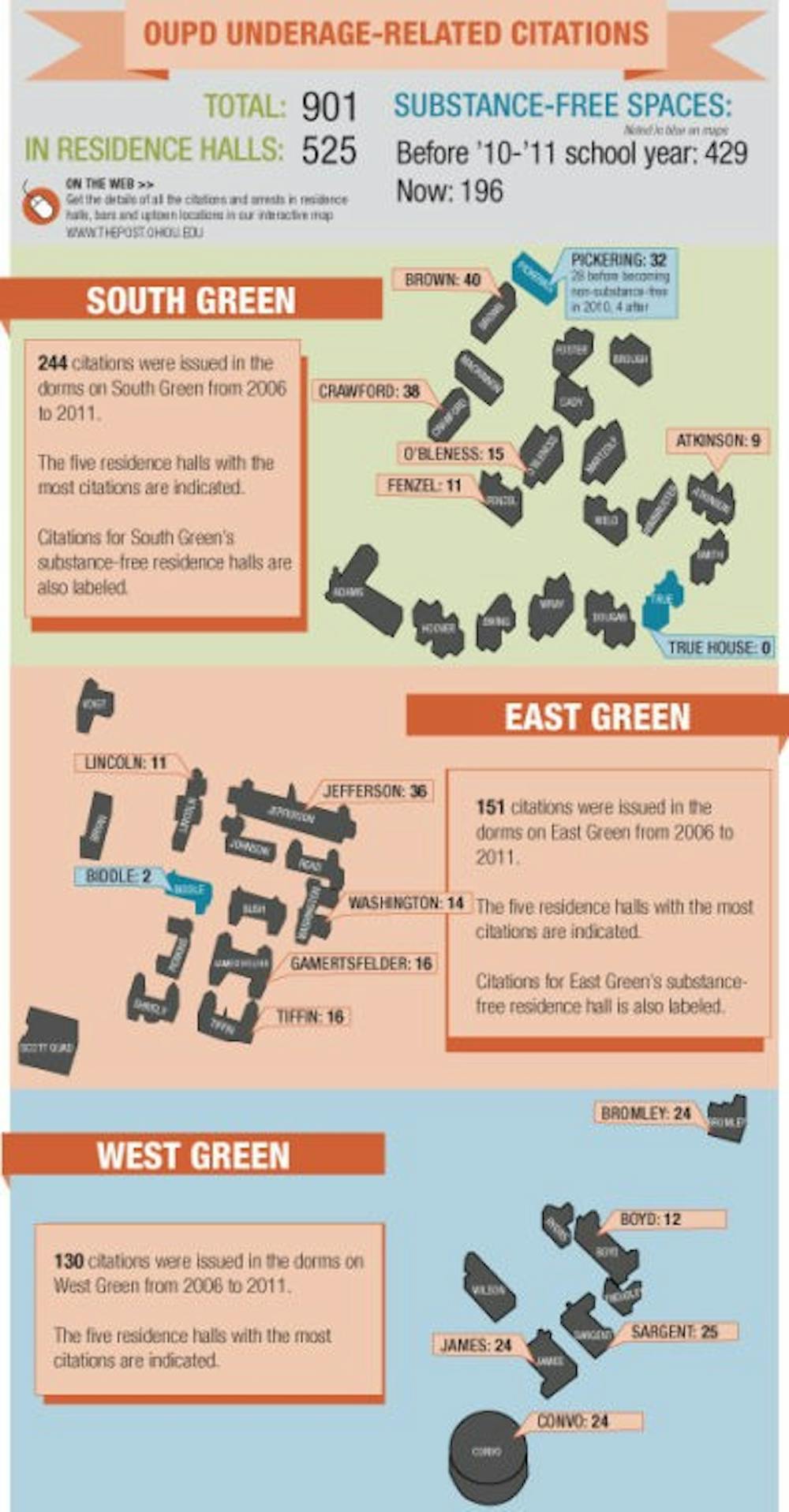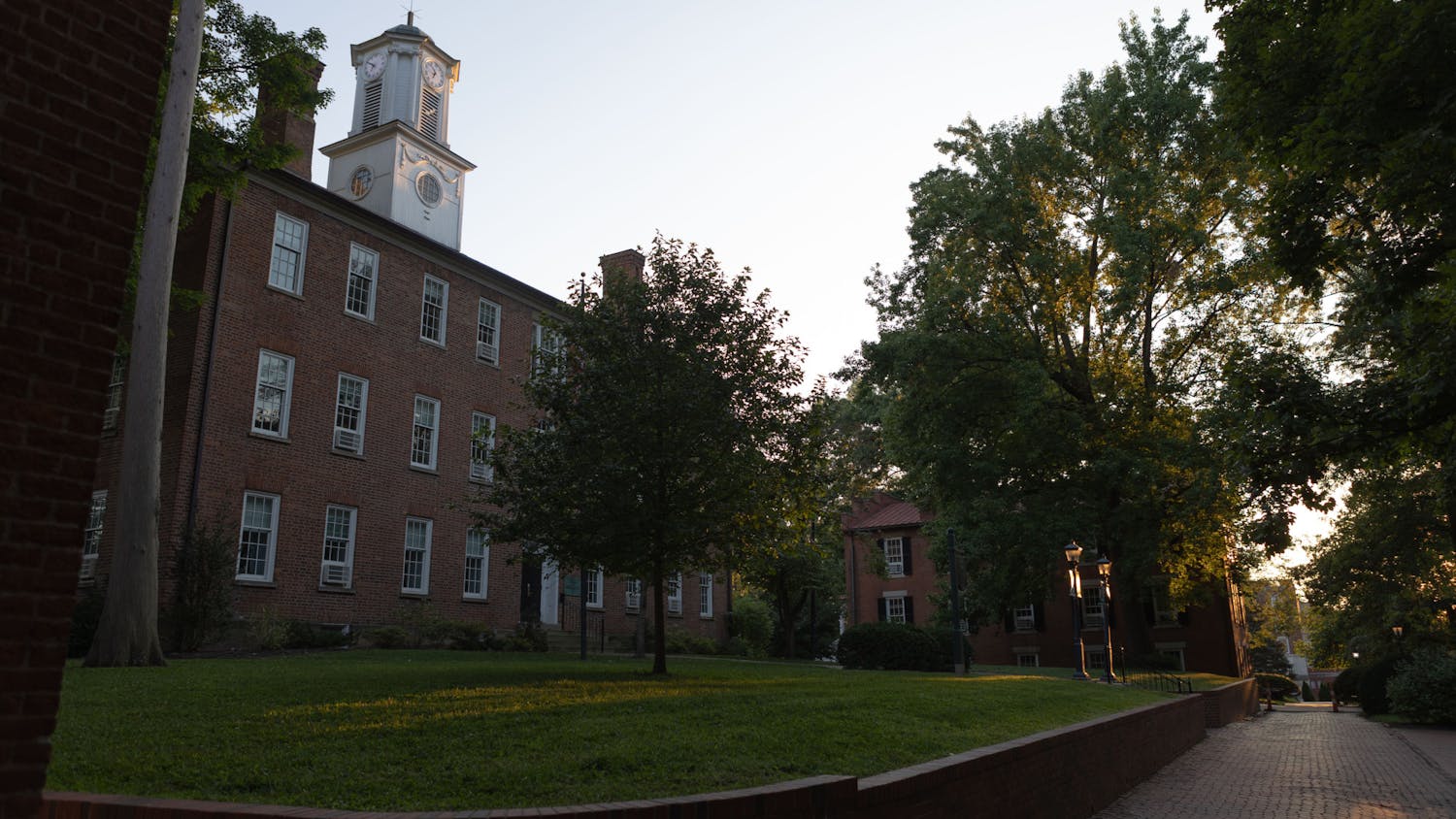Editor’s Note: This is the final day of a three-day front-page series examining underage drinking in Athens and at Ohio University. To protect identities, some sources are first-name only.
The aroma of stale “Natty Lite” and discarded Goodfella’s pizza plastered to the pavement lingers throughout campus Saturday and Sunday mornings, remnants of a college’s binge.
And though about the half people living in the dorms are freshmen and most likely cannot drink, the smells waft through the winding, poorly lit hallways as well.
“Drinking in the dorms is easy,” said Patrick Norway, an Ohio University student studying accounting. “As long as you handle yourself properly, there isn’t anything to worry about.”
He would know better than most.
“I came back to (Foster House on South Green) one night extremely wasted and apparently fell asleep in the elevator,” he said.
Not a soul questioned Norway’s comatose-like body lying haphazardly in the middle of the elevator for two hours — until his friend discovered him and pulled him to safety.
Regardless of Norway’s “easiness” claim, underage people are getting cited in the dorms. A Post investigation showed that about 58 percent of the 900 Ohio University Police underage-related alcohol citations from 2006 to 2011 occurred in the dorms — and of the more than 500 citations, 46 percent were on South Green.
Josh Bodnar, assistant director for sales, promotion and communication in Residential Housing, said he wasn’t aware of more citations on South Green but that the department tries to steer students away from underage drinking and toward responsible decision-making during their first days on campus.
“The discouragement begins at move-in,” Bodnar said. “We try to make them understand that it’s not OK. This institution takes underage drinking very seriously.”
The most citations occur on South Green, but it is home to 20 residence halls, while only 14 residence halls are located on East Green and eight are on West Green. But South Green dorms — such as Brown and Crawford halls — had the most citations of all residence halls on campus.
The number of dorm citations actually is higher because resident directors do not always call OU police when there is a problem. Sometimes the violations are documented in-house.
Despite the high volume of underage-related citations, senior dorm staff members said they do their best to prevent underage drinking from happening.
“We try to connect with the students before issues happen and hold them accountable from the get-go,” said Lindsey Marx, residential coordinator for Read, Johnson and Lincoln halls on East Green. “We develop a one-on-one relationship between the RAs and the residents.”
Most Cited Dorms
An accomplice manned every stairwell on each of Boyd Hall’s four floors — senses alert, knuckles clenched white around walkie-talkies. It was a Wednesday night — Operation Rolling Pig was a go.
When the coast was clear, two conspirators stealthily removed a hockey duffle bag from a black Jeep parked beneath the hall. Straining their ears for any crackle from their cohorts across the two-way radio, they lugged the bag up four flights of stairs.
Hidden in the bag was a keg of Milwaukee’s Best Light, condensation collecting on its metal exterior. The keg was nestled safely in Joe’s wooden closet before the underage crew knew it.
“We all had a celebratory beer,” said Joe, a 2007 alumnus. “We drank a lot of beer in the next few days and were pretty much the coolest dudes in Boyd Hall from there on out.”
Though the means to quench their underage thirsts might have been extreme, Joe knew they could get away with it because no one was paying attention.
“For a few weeks, we watched the patterns of the RAs in our building,” Joe said. “(We realized) that the RAs never really came out of their rooms unless needed.”
A Post investigation showed that West Green accounted for only 14 percent of OUPD’s underage-related citations from 2006 to 2011 — the lowest of the three residential greens. Only 12 citations were made in Boyd during that time period.
Sargent Hall, a coed freshman and upperclassman dorm that houses players from several Ohio Athletics teams, was the site of 25 citations, while Bromley Hall, a coed upperclassman dorm, was the location of 24.
South Green dorms were home to 46 percent of the underage-related citations during the time period. Brown Hall, a coed dorm for freshmen and upperclassmen, was the site of 40 citations, and Crawford Hall, also a coed dorm for freshmen and upperclassmen, was a close second with 38 citations.
Amanda Hobson, residential coordinator for Atkinson, Armbruster, Smith and True houses on South Green, couldn’t name specific dorms that posed problems for staffs but said dorms with first-year students always have higher violation numbers.
“All dorms have cycles where there are more documentations, but I don’t think there are any that consistently cause problems,” Hobson said. “Sometimes there’s an urban legend that a dorm is a ‘problem dorm,’ so residents live up to their own expectations.”
Although only 17 percent of the citations were in East Green dorms, Jefferson Hall, a coed freshman dorm, came in at third place with its 36 citations.
Marx worked in Jefferson last year but said she wasn’t comfortable labeling a dorm as a “problem dorm.”
Any hall has its issues that are addressed by resident coordinators or resident directors, she said.
OU Police Chief Andrew Powers would not speak about what areas of campus the force focused its energy on but said officers both proactively patrol and respond to complaints.
“We target our patrol efforts to problem areas based on activity, so the specific areas or buildings to which we provide extra patrols change over time,” Powers said.
If OU Police officers arrest someone in the dorms, the individual is charged with a criminal offense in Athens County Municipal Court. But officers also send a copy to the Office of Community Standards and Student Responsibility, where it is reviewed and a course of discipline is determined.
But OU Police officers are not always called.
“The senior staff (at the dorm in question) assesses the situation to determine if the student or students in question are in danger. If they are, OUPD is called,” Hobson said. “If it’s low-level, it’s handled in-house.”
When an incident is handled in-house, senior staffers review the case and issue a referral to the office, which will issue probation or a reprimand depending on the level of the offense, Hobson said. If it’s the student’s second offense, he or she can be suspended, she added.
The office was unable to provide the breakdown of how many referrals were issued in-house by deadline.
Living Substance-Free
Partying and drinking might be a good time for some, but Kelsey Hester sees it as only a temporary solution to stress.
“God desperately loves us so much that he wants us to run to him to completely satisfy us and make us whole rather than us trying to fill our lives with other things, such as hiding all our stress and worries behind drinking,” said Hester, a junior studying early childhood education.
Because of her beliefs, Hester chose to live in Biddle Hall, one of two substance-free dorms on campus, for two years.
“(I wanted) to be surrounded by people who had made the same choice,” Hester said. “I loved living in Biddle. … I had a safe place I could go back to and be surrounded by people who usually have similar beliefs.”
But fewer and fewer people are leaning toward the substance-free lifestyle.
There were three substance-free dorms available to students — Biddle on East and True and Pickering Hall on South — until 2010, when university officials eliminated Pickering from the list.
“Pickering was eliminated to try to reduce the number of students assigned into substance-free housing who were not truly committed to the substance-free lifestyle,” Bodnar said.
A Post investigation showed that almost 30 underage individuals were arrested in Pickering between 2006 and 2010. During that time, not a single person was arrested in True and only two were arrested in Biddle.
Pickering’s erasure from the list meant the number of substance-free spaces was cut in half, to almost 200 from about 430.
Residential Housing evaluates the number of substance-free residence halls each year based on the demand of the students. Officials determined there was sufficient space between the two remaining dorms for students truly interested in living substance-free, Bodnar said.
That lifestyle is something Evan Gruskiewicz, a junior RA in Biddle, takes very seriously.
“We have a zero-tolerance policy (in Biddle), and we have a good track record,” Gruskiewicz said. “We’ve got a really respectful bunch.”
Residents must sign a contract upon move-in, agreeing to neither drink nor have alcohol in the dorm. They also cannot return to the building intoxicated, regardless of their ages, Gruskiewicz said.
If an RA believes a resident violated the contract, they confront the individual, compile a report complete with PID numbers and send it to the standards office. A call is immediately made to OU Police.
Although RAs such as Gruskiewicz work hard to keep intoxicating substances out of substance-free residences, drinking can still happen.
Norway didn’t live in Biddle but said he frequently drank there without any consequences.
“It was so easy,” Norway said.
Prevention
From four-hour AlcoholEdu surveys to “Stop at the Buzz” posters plastered on concrete-block walls, Bodnar said Residential Housing heavily preaches prevention.
“We talk about responsible decisions and educate students on the facts about the risky behavior,” Bodnar said.
Individual residence halls run weekend programs throughout the year, encouraging students to participate instead of engaging in late-night binge-drinking sessions, Bodnar said.
“Our main emphasis is a sense of community to discourage people from drinking,” he said.
Some dorms on South, such as Atkinson, host movie nights on Fridays and game nights throughout the weekend that encourage residents to put down the bottle and stay indoors, Hobson said.
Those programs will have anywhere from three to 30 participants depending on the weekend, Hobson said.
But Bodnar knows that, sometimes, preventative measures are not enough. That’s why RAs are trained to react when various emergency situations arise.
All RAs complete a program called “Behind Closed Doors,” a simulation exercise where stressful situations — related to alcohol, grades and roommate conflicts — are staged to teach RAs how to respond.
“The simulation gives them an idea of what it will be like to confront a peer, which is sometimes difficult,” Bodnar said.
In Read, Johnson and Lincoln halls, RAs do rounds every night, sometimes four or more times, Marx said.
“It’s a chance to check on the students,” Marx said.
Regardless of the situation, senior staff members in every residence hall want students to remain safe.
“Our main priority is to keep students healthy,” Marx said. “Once that’s taken care of, we move from there.”
as218907@ohiou.edu






